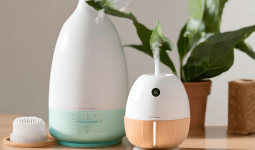This article offers many strategies for managing humidity in your home without a dehumidifier. It can be brutally humid.
Living, working, and sleeping there might be challenging. In addition to being uncomfortable, it can encourage mold or fungus growth in dwellings.
The cost of dehumidifiers might vary. There are also fantastic methods for reducing humidity, regardless of whether you suffer high humidity levels all year long or during specific seasons—these range from having a charcoal basket nearby to employing exhaust fans and hanging drying garments.
This post will outline more than ten techniques for managing humidity in your home without a dehumidifier.
Not all of them need to be completed. Just pick one or a few that fit your lifestyle the best.
Unfortunately, Using a dehumidifier is the simplest way to dry out a property.
However, purchasing one of these devices is relatively expensive, and they frequently use a lot of electricity.
Dehumidifiers occasionally make a home’s air overly dry, leading to a brand-new set of issues.
Fortunately, there are a few all-natural ways and other ways to manage humidity in your home without a dehumidifier. Let go
1. Open Windows
Opening windows in a humid environment may seem paradoxical, but doing so can keep the air circulating and humid air from condensing inside your home.
Almost moving air quality is usually preferable to still air quality, especially regarding humidity.
Even though the humidity level in a house is still relatively high, opening the windows can help it feel less humid.
Here are some clever techniques to make the most of an open window. First, don’t assume it needs to be fully opened; a lovely crack will do.
You can also enjoy the breeze by opening windows facing wind-blowing directions.
Third, prioritize opening windows in humid areas such as the kitchen and restrooms.
This is one of the natural and best ways to manage humidity in your home without a dehumidifier.
2. Absorb the Moisture
If you place pots of calcium chloride in troubled spots in your house, you should notice a rapid decrease in humidity levels. Most big hardware stores carry this chemical in powder form.
It is inexpensive and naturally absorbs moisture from the air’s excess humidity.
Absorbing moisture is one of the best ways to manage humidity in your home without a dehumidifier.
3. Vent Your Home
Improving ventilation is the easiest and most affordable approach to drastically reducing indoor humidity levels in a house without a dehumidifier.
Opening windows and doors as frequently as possible is the most straightforward approach.
Placing fans in trouble spots to keep the air quality moving can also be worthwhile.
It is also a good idea to install extraction fans in rooms of the house that are particularly prone to high humidity levels, such as the attic, the kitchen, and the bathroom.
This is one of the best ways to manage humidity in your home without a dehumidifier.
4. Use a Fan
Comparable benefits of opening windows exist with fans. They maintain airflow and keep your home’s air from becoming stagnant.
To lower humidity, you can utilize a variety of fans.
- Ceiling Fans: Ceiling fans can move air over a room from the top down and be lifesavers in humid climates. Even a ceiling fan on the lowest level can maintain a little more reviving breeze, particularly in bedrooms where you’re trying to fall asleep.
- Exhaust Fans: Remember to use exhaust fans! They are probably placed in your bathrooms and built into your appliances. The primary function of exhaust fans is to remove air from the space in which they are installed. Proactively use them by turning them on before you need them and leaving them on until you are finished using the kitchen or bathroom.
- Standing Fans: Traditional standing plug-in fans will do the trick in rooms without ceiling or exhaust fans. They can be used not only in rooms without other fans but also to improve the airflow in the entire house. Also, you can use standing fans and open windows to promote airflow without wind because you can move them anywhere.
5. Turn On The AC
Air conditioners cool the air and remove humidity. They will still dehumidify the space even if they aren’t set to a shallow temperature.
However, air conditioners can be costly in hot and humid climates.
However, once the room or house has reached the desired temperature and the humidity has been reduced, it is usually more accessible for the air conditioner to maintain the desired temperature and humidity levels.
This is one of the best ways to manage humidity in your home without a dehumidifier.
6. Remove Indoor Plants
Plants release moisture into the atmosphere, which can significantly and directly affect humidity levels. Put all your live indoor potted plants outside and replace them with artificial ones.
7. Dry Your Laundry Outside
Another action to lower humidity in your home is this. You should dry your stuff outside on a line.
Moving your laundry out should make a noticeable impact if you line-dry your clothes inside.
When you line dry your clothes indoors, all the water in your clothing evaporates into the air because it has nowhere else to go.
This might be a blessing in severely dry places, but in already humid places, it only increases the amount of water vapor in the air.
Furthermore, when using a dryer that vents to the outside, ensure the vent is properly secured to ensure that no moisture escapes back into your home.
This is one of the best ways to manage humidity in your home without a dehumidifier.
8. Take a Shorter and Cold Shower
The bathroom, especially showers, is the most significant source of humidity in most homes.
While taking showers, always ensure the ventilation fans are running, and afterward, leave the door and windows open for about 30 minutes.
Taking shorter showers can significantly reduce the moisture you let into your home.
Furthermore, steamy and hot showers produce steam, which may cause the air to become quite humid.
You can reduce shower water vapor’s effects on your home’s humidity by taking shorter, colder showers.
Lowering the shower’s temperature in the sweltering summer heat could be soothing.
Remember that every little amount matters when it comes to showers.
Therefore, if you typically take a long, intensely hot shower, turn it down to warm and cut the time in half.
Also, you ought to continue to notice how the humidity has changed.
9. Verify Your Rugs
Rugs may contribute to bad indoor humidity and dampness. They can even develop mold or fungus and retain moisture.
Fortunately, a quick sniff test should reveal any moisture problems on a rug. Give it a sniff; if it has a musty or damp smell, you can dry clean it or replace it.
This is one of the best ways to manage humidity in your home without a dehumidifier.
10. Fix Leaks
You may have a leaky pipe if you suddenly see water rings or marks on your walls.
The best action in this situation is to request assistance from a plumber.
Check under floors for busted pipes or a very high water table because leaks under your house may also be at fault for excessive humidity levels.
If your ceilings contain water stains, water may enter your home through the roof or gutters.
This is one of the best ways to manage humidity in your home without a dehumidifier.
11. Install Solar Air Heater
Although installing a solar air heater is pricey, it is arguably the best solution to a severe and persistent humidity issue.
The heater draws in fresh air or airflow from the outside. The air is pumped into the house after being warmed, dried, and filtered.
12. Dry Heat Source
Use dry heat wherever practical. Gas central heating is an effective way to heat a house, but if your house already has excessive humidity, it may worsen things.
Using a space heater or wood-burning stove simultaneously warms and dries the air.
Furthermore, Don’t go overboard with your dehumidifying efforts because it’s crucial to remember that a bit of humidity in a home is preferable.
By taking the appropriate actions and consistently checking the humidity levels on your property, you can establish a secure and comfortable living environment.
This is one of the best ways to manage humidity in your home without a dehumidifier.
13. Try Use Charcoal
Although charcoal may not be the most aesthetically pleasing item in your home, it effectively removes moisture from the air.
It can be something other than something exceptional. While regular charcoal works fine for grilling, coconut shell charcoal is less likely to crumble and create a mess.
What makes charcoal so great? It can have a major impact for up to three months or more before it needs to be replaced, and it is very reasonably priced.
This is one of the best ways to manage humidity in your home without a dehumidifier.
14. Use Baking Soda
Baking soda works well to remove moisture. You can buy some and put it in a dish with a lot of dampness.
Rock salt and charcoal work better in larger spaces, but baking soda works just as well in smaller rooms or areas of a house.
Additionally, it has a long-lasting ability to draw moisture out of the air before needing to be replaced.








